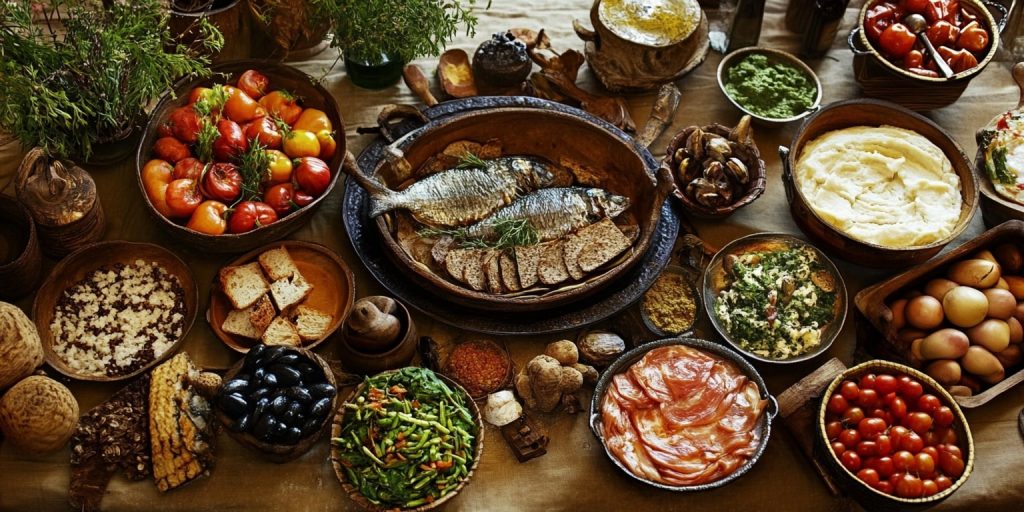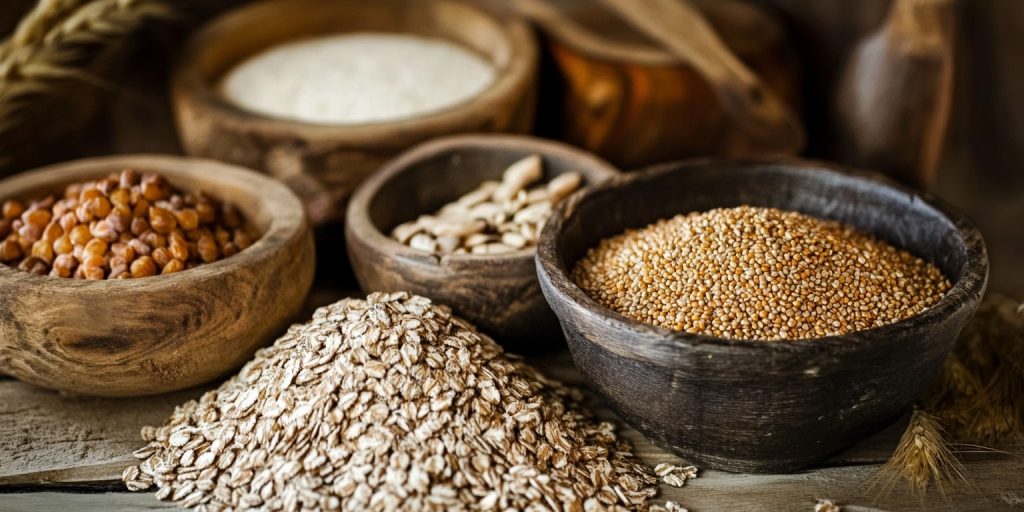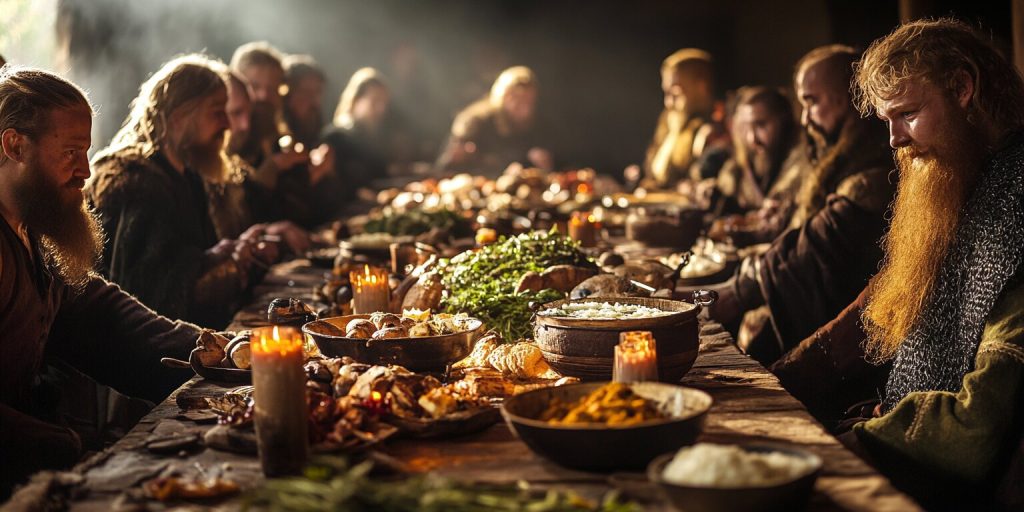Daily Life in the Viking Age, Viking Food and Drinks, Vikings
What Was The Staple Viking Meal?
The staple Viking meal was more than just food. It was the heart of their cuisine and their bond with the land. Grains like barley, oats, and rye were key in the typical Viking diet, forming the basis of many daily meals. They made porridge, a favorite among the Vikings.
Seasonal food was important as Vikings grew various crops throughout the year. Vikings were great at fishing and hunting. This gave them a diet full of meats from pigs, sheep, cattle, and fresh fish, typical of Viking history.
Root vegetables and foraged berries were added to their meals, showing the variety in the Norse diet. Sagas and Eddas tell us about their feasts, representing how meals were part of their farming and daily lives.
Introduction to Viking Cuisine
Viking cuisine started during the Viking Age, from about 793 to 1066 AD. This time was key in shaping Scandinavian food. Vikings mixed local foods with ones they got from trading and exploring.
This shows us a lot about Norse culture. Their meals often showed off big feasts and times when people came together. These meals helped build strong social bonds through food, as sharing stews and mead was common among the Vikings.
Understanding the Viking Age
The Viking Age was full of exploration, trade, and cultural sharing, which helped traditional Viking food grow and change. As Vikings went to new places, they found new foods and ways to cook, expanding their range of food and culinary techniques.
This mix of new tastes and textures made their food special, reflecting Norse and Viking culinary traditions. It also showed how resourceful and adaptable the Vikings were in a changing world, as they slaughtered animals and cultivated crops to ensure food security.
The Importance of Diet in Norse Culture
The Viking diet was more than just for eating. It was a big part of Norse culture. Meals were shared with others, helping to keep family and community ties strong.
The Viking diet was full of protein and carbs, perfect for an active life, as they often included a variety of foods in their daily meals. It was filled with exploration and battles. Their food ways told us a lot about what the Norse valued and their social life, with food at the heart of it all.
What Was The Staple Viking Meal?
The Viking diet was shaped by their environment and what they could find. A few key foods were at the heart of their meals. These foods gave them energy, nourishment, and taste.

Main Ingredients of Viking Meals
Grains like barley and oats were key in Viking meals and often featured in their cookbooks. They turned these grains into porridge, a main source of energy, and bread from these grains was also important in their diet.
Meat from animals like sheep and pigs provided protein. Fish from the waters around Scandinavia was another protein source. Herbs like dill and coriander added flavor. Preserved fruits added sweetness to their dishes, a technique found in many Viking cookbooks, highlighting their use of fruit and vegetables.
Typical Preparation Methods
Vikings used many cooking methods to maximize their food. They boiled, roasted, and smoked their food, often preparing hearty stews that were a staple in their diet. These methods made the food taste better and helped preserve it.
Their cooking was simple, using ingredients they had on hand. Archaeologists have found Viking recipes that show their cooking was practical and creative.
Common Food Sources in the Viking Diet
The Viking diet was based on what they found in their environment, including whale meat during their expeditions. They ate a mix of foods that helped them live strong lives. Each type of food was key to their diet, making them strong and able to keep going.
Meat and Fish: Primary Proteins
Meat and fish were key to the Viking diet. They had a lot of livestock, such as pigs, cows, and sheep, which provided them with a lot of protein.
Living by the sea meant they also ate a lot of fish, especially herring, which was common in Viking Age Scandinavia. They knew many ways to cook these foods, making the most of what they had.
Grains and Cereals: The Backbone of Meals
Grains and cereals were the base of many Viking meals. They ate barley, oats, and rye for energy, which were essential components of the daily meals the Vikings would enjoy. These grains were used in porridge, bread, and even mead, a big drink in Viking times.

Growing these crops showed how close the Vikings were to the land and its gifts, as evidenced by archaeological findings of plant remains.
Dairy Products: A Vital Component
Dairy was a big part of the Viking diet, adding taste and nutrition. They made milk, cheese, and skyr from their cows and goats. These foods added flavor and important nutrients to their meals.
Using dairy showed how clever the Vikings were at using all the food they had.
Seasonal Availability and Preservation Techniques
The tough climate in Scandinavia was key to Viking food culture. With short growing seasons, Vikings had to make sure they had enough food all year. They learned a lot about seasonal food and how to store it for winter.
Short Growing Seasons in Scandinavia
Farming was difficult in this tough place. Planting and harvesting had to be done just right. The Vikings knew which crops could grow in the cold. They planned carefully to prepare for the cold months when food was hard to find, often relying on preserved fruits and vegetables.
Methods of Food Preservation
Vikings used drying, salting, and smoking to keep food fresh. These methods helped them eat well during the cold winter, and they also used the cold weather to keep food fresh, showing their smart ways to deal with farming challenges.
Conclusion
In conclusion, the staple Viking meal was a reflection of resourcefulness and adaptability coupled with an intimate link to nature by the Norse people. Their food included crops, meat, and vegetables in season, not only for sustenance but also for social and cultural purposes.
Simple modes of food preparation and ingenuity in food preservation helped them adapt and succeed in the harsh climate of Scandinavia. Food is what one finds where resilience, known for being connected through shared bonds and profoundly respectful of the land that sustained them, takes form within that culture. The Viking diet was not only for sustenance but also made them strong, hardy Norsemen, thanks to the diverse ingredients they incorporated into their daily meals.

